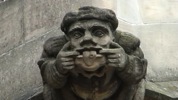The following words are from Robert Durling, recent English translator of Petrarch.
Petrach’s themes are traditional, his treatment of them profoundly original.
From Propertius, Ovid, the Troubadors, the Roman de la Rose, the Sicilians, the dolce style novo, Dante, Cino da Pistoia
there comes to him a repertoire of situations, technical vocabulary, images, structures.
Love at first sight, obsessive yearning and lovesickness, frustration, love as parallel to feudal service;
The lady as ideally beautiful, ideally virtuous, miraculous, beloved in heaven, and destined to early death;
Love as virtue, love as idolatry, love as sensuality;
The god of love with his arrows, fires, whips, chains;
War within the self- hope, fear, joy, sorrow.
Conceits, wit, urbane cleverness; disputations and scholastic precision;
Allegory, personification;
Wooing, exhortation, outcry;
Praise, blame; self-examination,
Self-accusation, self-defense;
Repentance, and the farewell to love.
Petrarch’s originality lies in the intensity with which he develops and explores them in the rich, profoundly personal synthesis of divergent poetic traditions, in the idea of the collection itself.
Now we reach the Author? Who i can’t identify but it’s from p. 15. If anyone knows who this author is please help me identify for credit.
It (the Sonnet form) is unique in demanding an especially complex interrelationship of structural units- single lines, groups of four, groups of eight and six, couplets- within the very strictly imposed limit of fourteen rhymed lines equal in length.
These demands taught Wyatt to use language in a new ways that distinguish his sonnets. To these possibilites the sonnet sequence, of which Sidney’s is the first in English, added other opportunities.
While retaining the effects of condensation or compression within the individual sonnet, the sequence allowed indefinitely expanded variations on it.
Its matter could be explored, complicated, modified, revised, questioned, criticized, ridiculed without loss of focus on the figure of the poet-lover presented throughout.
This made the sequence, as well as the sonnet form itself, a vehicle for some poets to complicate and expand the analyses of what is in the heart.
US: if the sonnet sequence is a vehicle, then it follows the workings of a sonnet could be compared to a combustion engine.
Suck Quatrain 1 a question or statement is posed.
Squeeze Quatrain 2 a riposte or development of same.
Bang Quatrain 3 jumps to its highest, deepest or most essential level
Blow C final couplet closes or opens the argument: leaving a salt, sweet, bitter, or sour taste.
Of course Petrarch was outmoded by the time Shakespeare worked his magic. Here’s his anti-Petrarchan sonnet 130:
Q130
MY Mistress’ eyes are nothing like the Sun,
Coral is far more red, than her lips’ red,
If snow be white why then her breasts are dun:
If hairs be wires, black wires grow on her head:
I have seen Roses damask’d, red and white,
But no such Roses see I in her cheeks,
And in some perfumes is there more delight,
Than in the breath that from my Mistress reeks.
I love to hear her speak, yet well I know,
That Music hath a far more pleasing sound:
I grant I never saw a goddess go,
My Mistress when she walks treads on the ground.
And yet by heaven I think my love as rare,
As any she belied with false compare.

Leave a Reply
You must be logged in to post a comment.